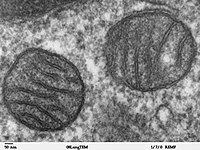
Photo from wikipedia
Curcumin exhibits antioxidant properties in normal cells where the uptake is low, unlike in tumor cells where uptake is high and curcumin increases reactive oxygen species (ROS) production and cell… Click to show full abstract
Curcumin exhibits antioxidant properties in normal cells where the uptake is low, unlike in tumor cells where uptake is high and curcumin increases reactive oxygen species (ROS) production and cell death. Mitochondria are the main source and primary target of cellular ROS. We hypothesized that curcumin would regulate cellular redox status and mitochondrial function, depending on cell sensitivity and/or curcumin concentration in normal cells. We examined the differences between low and high concentrations of curcumin, with specific attention focused on ROS levels, mitochondrial function, and cell viability in mouse C2C12 myoblast under normal and simulated conditions of diabetes. Cells incubated with high concentrations of curcumin (10–50 μM) resulted in decreased cell viability and sustained robust increases in ROS levels. Mechanistic studies showed that increased ROS levels in cells incubated with 20 μM curcumin induced opening of mitochondrial permeability transition pores and subsequent release of cytochrome c, activation of caspases 9 and 3/7, and apoptotic cell death. Low concentrations of curcumin (1–5 μM) did not affect cell viability, but induced a mild increase in ROS levels, which peaked at 2 hr after the treatment. Incubation with 5 μM curcumin also induced ROS‐dependent increases in mitochondrial mass and membrane potential. Finally, pretreatment with 5 μM curcumin prevented high glucose‐induced oxidative cell injury. Our study suggests that mitochondria respond differentially depending on curcumin concentration‐dependent induction of ROS. The end result is either cell protection or death. Curcumin may be an effective therapeutic target for diabetes and other mitochondrial diseases when used in low concentrations.
Journal Title: Journal of Cellular Physiology
Year Published: 2019
Link to full text (if available)
Share on Social Media: Sign Up to like & get
recommendations!